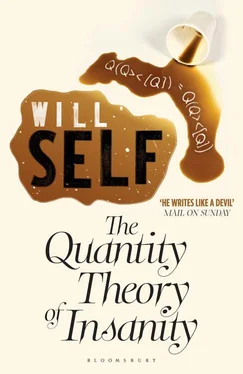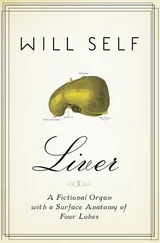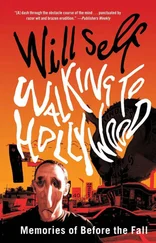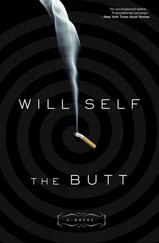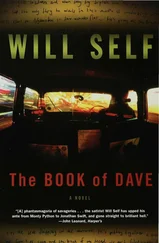And as for the rest of them, those tedious souls who I saved from a lifetime of near-obscurity, they all proved unworthy of the gifts conferred upon them by their proximity to genuine theoretical advance. Hurst was at least predictable, even if his actions were in some ways the most odious.
It was about nine months after the afternoon I spent in Hampstead that I first read an item in the newspaper which confirmed my worst suspicions about him. Short and to the point. It said that Phillip Hurst, the noted statistician and psychologist, one of the originators of the Quantity Theory of Insanity, had been appointed by the government to head up a new bureau loosely attached to the Central Office of Statistics, but charged with a novel task — a sanity quotient survey of the whole country. The aim was to develop an effective measure of the quotient so that central government could accurately fix and concentrate its deployment of palliatives, in the form of funds spent on mental health, to create a fair and weighted distribution of aberrant behaviour throughout the realm.
I stopped waiting for more news. I knew it would be bad. I took the first academic job that I could lay my hands on that would take me as far away as possible from the onrush of the demented juggernaut I had spawned. In Darwin, in the Northern Territory of Australia, I sat and I waited. On Saturday mornings I would climb into my Moke and drive down to the Victoria Mall where the only good newsagent in Darwin kept newspapers, three and four days old, from around the world.
So it was, standing amongst men with elephant-skin crotches of sweated, bunched, denim shorts, that I read, while they scratched at Tatsalotto cards, the plastic shavings falling around their thongs. The news was all of strange theatrical events of extreme violence. The newspaper editors published programme notes, replete with heavy black arrows, and the sort of drawings of men wearing windcheaters and carrying machine pistols you would expect to find on Letraset sheets.
As for the government’s attempts to arrive at an accurate way of measuring the sanity quotient, these were dogged by problems that on the one hand seemed to be purely semantic — and which on the other appeared as worrying, aberrant, unknowable.
First one measure of sanity, then another, and then several more were developed in an effort to arrive at the definitive. The problem was that the straightforward measure S 1was arrived at by a number of calculations — the rate in the increase of schizophrenic diagnoses was indexed against the rate of increase in the population — which were themselves open to different methods of calculation and hence interpretation.
Even when the various warring ‘experts’ (who were these people? Where had they been when I was crouching in bothies in the Western Highlands, or roaming the toilets of central London?) could agree on a given measure, it soon manifested mathematical instabilities which rendered it unworkable, or incalculable, or both.
S 9had quite a vogue. It involved adding together all the doses of Valium, or other related sedative drugs, prescribed in the country over a given period of time. Dividing the sum by a base unit of 5 mg and then dividing that figure by the incidence of advertising for stress-relief products on each regional television network. Musselborough, at one time a swingeing and totally unsympathetic critic of my work on job reductivism, did his best to associate himself with S 9, which for a while had a considerable following, measuring, its proponents claimed, not only the base sanity quotient, but also assessing the direction and rate of change of that quotient throughout the society. But the figure itself would fluctuate over quite short periods in such an alarming way as to throw serious doubts on the validity of the data being assembled.
I watched from Millarrapulla Road with detached amusement. The life there was a good one. Every month or so the director at the local college where I taught invited me for a barbecue, and together with other men in short-sleeved shirts, pressed shorts and white kneesocks I would stand out on the lush lawn and listen to the flying foxes as they whistled into land chattering in the mango trees. The other men were bland, white, tolerable. They lived in a society where constant rates of sanity had been achieved by the creation of a racial underclass which was killing itself with alcoholism. Actually, the overclass was killing itself with alcoholism as well, but there were remarkably few sufferers from any of the major pathologies.
Simon Gurney came to visit me for a while. He was convivial company; I would come back from the college in the evening and find him sitting with a small group of Groote Eylandters as they deloused one another on the veranda. Gurney worked hard and at the end of his visit presented me with a six-foot-high featureless basalt slab which I have to this day.
The spectacle of a growing, centralised bureaucracy, labouring to implement centralised policies based on the findings of Quantity Theory, filled me with amusement. As did the news that university department after department found it necessary not only to incorporate the theory into its undergraduate syllabus, but also to seek funding for all manner of research based on the possible applications of Quantity Theory to areas as diverse as North Sea oil production and the training of primary school teachers.
From time to time a journalist or a doctoral student would seek me out. I suppose I had the cachet of being the ‘founding father’, but in practice this meant very little. I think that when these people arrived, toiling up suburban roads, driven into psychosis by the heat, they found someone not altogether to their taste, someone not prepared to present them with an easily definable and analysable set of personal characteristics. The theses and profiles, when in due course they appeared, reflected this difficulty. Put simply: they just didn’t know what to make of me. I clearly wasn’t a bohemian and yet I had dropped out. I had no charisma to speak of, I had gathered no disciples around me and yet I was by no means eccentric. I wasn’t even eccentrically ordinary; a Magritte found in his own tropical Brussels.
Inexorably my reputation began to grow. Mostly, I think, as a result of the failure of my former colleagues to retain any kind of unity with their opinions whatsoever. So, although at the beginning of the Quantity Age my name was seldom if ever heard, within five years or so Busner, Harley, Hurst and even Sikorski were driven into mentioning my name as representing the benchmark of orthodoxy, in opposition to the wholly misguided views of one another. I suppose there was a strange sort of satisfaction in this success-for-all-the-wrong-reasons. Certainly the large cash sums from royalties on dusted-off and republished papers came in handy; and I was also shrewd enough to bargain up my price for an interview.
When the offer came to take a job with PiggiBank I seriously considered it. They flew me by private jet from Darwin to Tokyo. A bizarre seven-hour drive took me so slowly from the airport to my destination (a ‘country’ inn outside the conurbation, of which the chairman was a fanatical patron) that I felt despotic, borne at shoulder height through the press of so many tens of thousands of short people.
I appreciated the chairman’s meeting place. The inn, sited in a counterpane fold of green land, sweeping down from the conical peak of a hill which stood out against the dirty blue of a static sky, was horned and crouching, its roof a crisp pile of upturned toast-corners curling and calcined. Behind the inn towards the hill was a petrol refinery, or a chemicals plant, or some such thing — a twisted root of tangled knots of pipe.
‘Wal!’ The chairman’s greeting was as effusive as a baby’s fart through a muted trumpet. He and his people moved around the room, gesturing, giving me morsels, getting Japanese servants to give me morsels and drinks; and to give them morsels as well. They went out into the garden through the screen doors and then came back in again. Their movements around the room, with its polished block floor, lacquered furniture and paper walls, were lecherous. They molested the space. Every time their pink hands clutched at it, or their coarse faces rubbed against it, it shrank into itself, a little more hurt, a little more damaged.
Читать дальше
